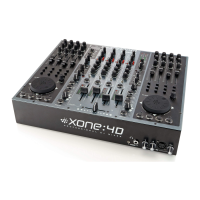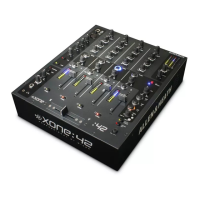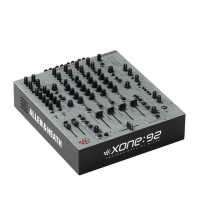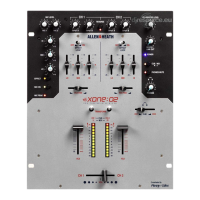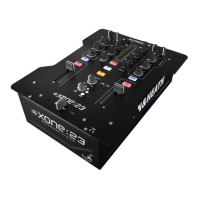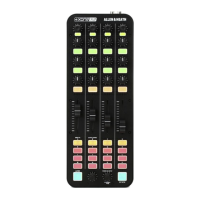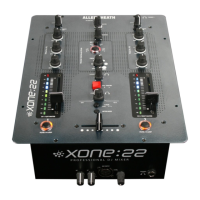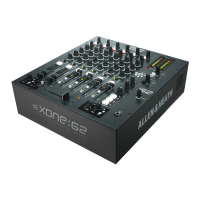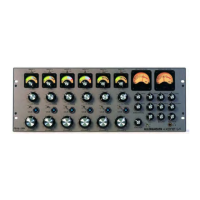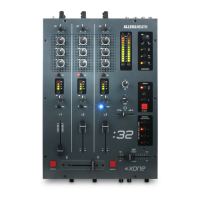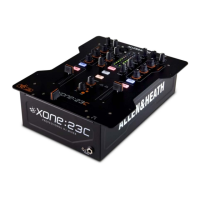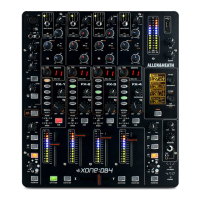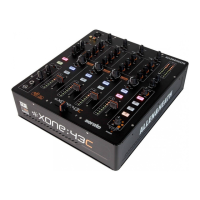
Do you have a question about the ALLEN & HEATH XONE:43C and is the answer not in the manual?
| Sample rate | 96 kHz |
|---|---|
| Channels quantity | 16 channels |
| Digital sound processing | 24 bit |
| Line Signal-to-Noise Ratio (SNR) | 20 dB |
| Total Harmonic Distortion (THD) | 0.05 % |
| Microphone in | Yes |
| Headphone connectivity | 3.5 mm |
| Product color | Black |
| Video capability | No |
| Power consumption (typical) | 30 W |
| Equalizer bands quantity | 3 |
| Depth | 370 mm |
|---|---|
| Width | 320 mm |
| Height | 110 mm |
| Weight | 5200 g |
Details requirements for warranty service and user responsibilities.
States liability limitations regarding data loss and consequential damages.
Mentions CE compliance with EMC and Low Voltage directives.
The main DJ mixer unit included in the package.
Lists spare parts, power lead, and USB lead provided.
Important safety information to read before operating the equipment.
Visual guides for connecting CD players, turntables, and controllers.
Specific setup for using Serato DJ with controllers and media players.
Details on connecting microphone and line-level audio sources.
Explains gain, EQ, cue, and on/off functions for the channel.
Controls for input gain, source selection (Phono, USB, Line).
Describes the 3-band EQ and external effects send/return functionality.
Controls for crossfader assignment and routing to the VCF filter.
Functionality for pre-fader monitoring and signal level indication.
Operation of the smooth travel fader for volume control.
Control over filter resonance and routing X:FX return to the filter.
Explains HPF, BPF, and LPF filter slopes.
Adjustment of the filter's cut-off frequency across the audio spectrum.
Options for headphone cueing and mixing main output with cue signal.
Details on headphone jacks and volume adjustment.
Displays for main mix and cued channel levels for monitoring.
Controls for main mix output level and separate booth output level.
Functionality for fading between audio signals for mixing.
Control to modify the crossfader's response curve for different mixing styles.
Details on AC mains input and Phono/Line inputs for channels 1-4.
Information on X:LINK connectivity and USB ports for computer connection.
Switches to select USB input for Serato DJ Club Pack.
Master output, record out, booth output, and chassis earth connection.
RCA connections for external effects processing.
Steps to download, install, and restart for Mac OS driver.
Steps for downloading, installing, and rebooting for Windows ASIO driver.
Table detailing default input/output routing for the 16-channel soundcard.
Explains how to reconfigure USB soundcard routing using internal jumpers.
Information on purchasing Serato DJ Club Kit and connecting the mixer.
Driver considerations for Mac and Windows operating systems.
Guidance on using DVS or Control CD with Serato DJ.
Steps to enable Vinyl/CDJ control within Serato DJ's setup screen.
How to expand the setup using X:LINK with compatible controllers.
Introduction to MIDI, its use in DAWs, and the mixer's MIDI features.
Procedure for changing the mixer's MIDI channel via button combinations.
Visual guide for setting MIDI channels using switches.
Explains MIDI channel numbers, parameter numbers, and message types.
MIDI control assignments for Mic/Aux and channel CUE functions.
MIDI control assignments for channel filters and X:FX.
Tables mapping note numbers to MIDI values and hexadecimal codes.
Diagram illustrating all connectors and controls on the rear panel.
Diagram showing all controls and indicators on the front panel.
Specifies output levels, headroom, and frequency response range.
Details distortion, crosstalk, and residual noise performance.
Covers faders, filters, digital architecture, consumption, and physical size.
Visual representation of how audio signals travel through the mixer.
Explanation of voltage-controlled filters and their tonal effects.
Graphs illustrating the frequency response for Hi-Pass, Band-Pass, and Low-Pass filters.
Guidance on setting optimal signal levels for best quality and headroom.
Explanation of dynamic range, signal-to-noise ratio, and avoiding clipping.
Notes on ear fatigue and maintaining sound quality over volume.
Importance of earthing for electrical safety and minimizing hum.
Advice on avoiding earth loops and ensuring proper grounding.
Recommendations for using quality cables and ensuring proper connections.
Required tools and initial steps for crossfader replacement.
Instructions for removing screws and separating mixer components.
Detailed steps for unplugging wireforms and removing the crossfader plate.
Instructions for installing the new crossfader and reassembling the unit.
